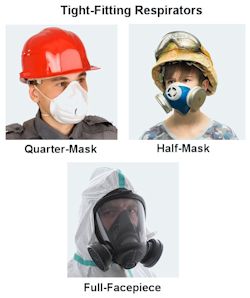Respirator Types
To understand how respirators can be used to protect employees, it is important to understand what a respirator is and what it is not.
A respirator protects against respiratory hazards by removing specific air contaminants from the ambient (surrounding) air or by supplying breathable air from a safe source.
- Air-purifying respirators: Respirators that remove contaminants from the ambient air are called air-purifying respirators. Particulate respirators are a type of air-purifying respirator. The part of a respirator that forms a protective barrier between the user's respiratory tract and air contaminants is called an inlet covering. Most inlet coverings are classified as either tight-fitting or loose-fitting.
- Tight-fitting respirator: A tight-fitting respirator has an inlet covering, also called a face piece or mask, designed to form a seal with the face of the wearer. It is available in three types: quarter mask, half mask, and full face piece.
- Loose-fitting respirator: A loose-fitting respirator has an inlet covering that typically covers the user's head and may extend over the shoulders. It is designed to form a partial seal with the face. These include loose-fitting face pieces, as well as hoods, helmets, blouses, or full suits, all of which cover the head completely.
- Atmosphere-supplying respirators: Respirators that supply air from a safe source other than the ambient air are called atmosphere-supplying respirators. There are two types of atmosphere-supplying respirators: Supplied-Air Respirators (SARs) and Self-Contained Breathing Apparatus (SCBA).
Knowledge Check Choose the best answer for the question.
2-2. Which type of respirator supplies air from a safe source other than the ambient air?
You forgot to answer the question!

